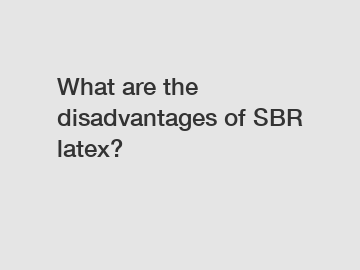Feb. 06, 2024
Chemicals
What are the disadvantages of SBR latex? SBR latex, or styrene-butadiene rubber latex, is widely used in various industries due to its excellent performance and cost-effectiveness. However, it is not without its drawbacks.
One of the main disadvantages of SBR latex is its limited heat resistance. This latex material has a lower heat resistance compared to other rubber compounds, making it unsuitable for applications that involve high temperatures or extreme heat conditions. For example, in the automotive industry, SBR latex may not be the best choice for components that are exposed to the engine's heat because it may degrade and lose its properties over time. This limitation restricts its use in certain manufacturing processes and applications where higher temperatures are involved.
Another disadvantage of SBR latex is its poor resistance to chemicals. While it offers good resistance to water and weathering, it may suffer from degradation when exposed to certain chemicals such as oils, solvents, and acids. This can lead to a reduction in the material's performance and durability. Consequently, SBR latex may not be suitable for applications that require contact with aggressive chemicals, such as in the construction industry where it is exposed to various chemical agents.

Moreover, SBR latex has inferior tear strength compared to natural rubber latex. While it provides good abrasion resistance and flexibility, it is more prone to tearing or puncturing under excessive strain or stress. This limitation can affect the lifespan and reliability of products made with SBR latex, especially in applications that require high durability or resistance to mechanical forces, such as tires or industrial seals.
The disadvantages of SBR latex stem from its chemical composition and structure. SBR latex is a synthetic rubber compound that is made from the polymerization of styrene and butadiene. The presence of styrene in SBR latex contributes to its limited heat resistance and poor chemical resistance. Additionally, the specific arrangement of the butadiene molecules in the polymer chain affects its tear strength.
Understanding the limitations of SBR latex is crucial for industries and manufacturers when selecting the appropriate materials for their products. Although SBR latex may not be suitable for applications requiring high heat resistance, chemical resistance, or tear strength, it still offers various advantages, such as good abrasion resistance, flexibility, and cost-effectiveness. By carefully considering the specific requirements and conditions of the application, alternative rubber compounds with improved properties can be chosen to meet the desired performance standards.
In conclusion, SBR latex has several disadvantages including limited heat resistance, poor resistance to chemicals, and inferior tear strength. These limitations arise from the nature of its chemical composition and structure. However, these drawbacks should not overshadow the performance advantages and cost-effectiveness that SBR latex offers. By weighing the pros and cons, industries and manufacturers can make informed decisions to optimize the use of SBR latex or explore alternative rubber compounds to meet their specific application needs.
For more information, please visit polyurethane backed artificial grass, difference between latex and rubber, Styrene Butadiene Latex for Bitumen.
Previous: What is the purpose of the cellulose?
Next: Unveiling the Ultimate Guide to N-Tert Butoxycarbonyl 4-Piperidone: FAQs, Benefits & Usage
If you are interested in sending in a Guest Blogger Submission,welcome to write for us!
All Comments ( 0 )